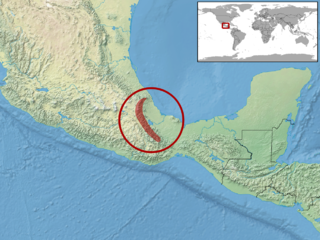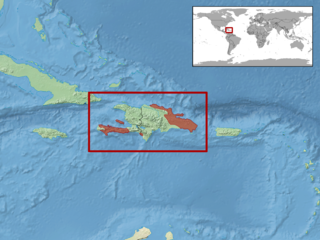
Celestus is a genus of diploglossid lizards mostly endemic to Jamaica and containing about 11 species, though three of these may be extinct. They are commonly known as galliwasps although the origin of this name is unclear. Formerly, this genus had more than 31 species, but a 2021 phylogenetic study found this classification to be paraphyletic and split those species into their own genera. A more recent study found that several ecomorphs exist on Jamaica including a swamp ecomorph, a tree ecomorph, and a ground ecomorph.

The eastern chipmunk is a chipmunk species found in eastern North America. It is the only living member of the genus Tamias.

The striped polecat, also called the African polecat, zoril, zorille, zorilla, Cape polecat, and African skunk, is a member of the family Mustelidae that resembles a skunk. The name "zorilla" comes from the Spanish word "zorillo", meaning "skunk", itself a diminutive form of the Spanish "zorro," "fox." It lives predominantly in dry and arid climates, such as the savannahs and open country of Central, Southern, and sub-Saharan Africa, excluding the Congo Basin and the more coastal areas of West Africa.

The typical striped grass mouse is a small rodent of the suborder Myomorpha in the family Muridae.

Caribicus anelpistus, the Altagracia giant galliwasp, is a species of lizard of the Diploglossidae family endemic to the Dominican Republic on the Caribbean island of Hispaniola.
Celestus duquesneyi, commonly known as Duquesney's galliwasp or the blue-tailed galliwasp, is a species of lizard in the family Diploglossidae. The species is endemic to Jamaica.
Celestus fowleri, also known commonly as the bromeliad galliwasp and Fowler's galliwasp, is a species of lizard in the family Diploglossidae. The species is endemic to Jamaica.
Celestus microblepharis, the small-eyed galliwasp or tiny eyelid galliwasp, is a species of lizard in the Diploglossidae family. It is found only in Jamaica.

The Jamaican giant galliwasp or sinking galliwasp is a possibly extinct species of lizard in the Diploglossidae. It was endemic to Jamaica. It was last recorded in mid-19th century, with locals reporting unconfirmed sightings. Its population has been ravaged and exterminated by introduced predators like mongooses. Recent surveys, while extensive, have not yet been exhaustive, given the difficulties of access into and around the Black River Morass, leaving room for some hope that the species may persist, albeit with a tiny population.

Caribicus warreni, commonly known as the Haitian giant galliwasp or the Hispaniolan giant galliwasp, is a species of lizard in the family Diploglossidae. The species is endemic to the island of Hispaniola.

Diploglossidae is a family of anguimorph lizards native to the Americas, with most genera being endemic to Hispaniola. Most members of this family are known as galliwasps. They were formerly considered a subfamily of Anguidae, but genetic evidence has shown them to be less closely related to other members of Anguidae than Anniellidae is.
Celestus barbouri, also known commonly as Barbour's galliwasp and the limestone forest galliwasp, is a species of lizard in the family Diploglossidae. The species is endemic to Jamaica.
Celestus crusculus, the Jamaican galliwasp or Garman's galliwasp, is a species of lizard of the Diploglossidae family. It is found in Jamaica.
Caribicus darlingtoni, also known commonly as Darlington's galliwasp and the Hispaniolan striped galliwasp, is a species of lizard in the family Diploglossidae. The species is endemic to the Dominican Republic on the Caribbean island of Hispaniola.

Siderolamprus enneagrammus, the Huaxteca lesser galliwasp, is a species of lizard of the Diploglossidae family. It is found in Mexico.
Celestus hewardi, also known commonly as Heward's galliwasp, the red-spotted galliwasp, and the three-streaked galliwasp, is a species of lizard in the family Diploglossidae. The species is endemic to Jamaica.
Celestus macrotus, La Selle galliwasp or Thomas's galliwasp, is a species of lizard of the family Diploglossidae. It is found in Haiti.

Sauresia sepsoides, the Hispaniolan four-toed galliwasp or common four-toed galliwasp, is a species of lizard of the Diploglossidae family endemic to the Caribbean island of Hispaniola. It is the only member of the genus Sauresia.

Comptus stenurus, the Hispaniolan keeled galliwasp or Cope's galliwasp, is a species of lizard of the Diploglossidae family endemic to the Caribbean island of Hispaniola.
Celestus molesworthi, the Jamaican galliwasp or Garman's galliwasp, is a species of lizard of the Diploglossidae family. It is found in Jamaica.









